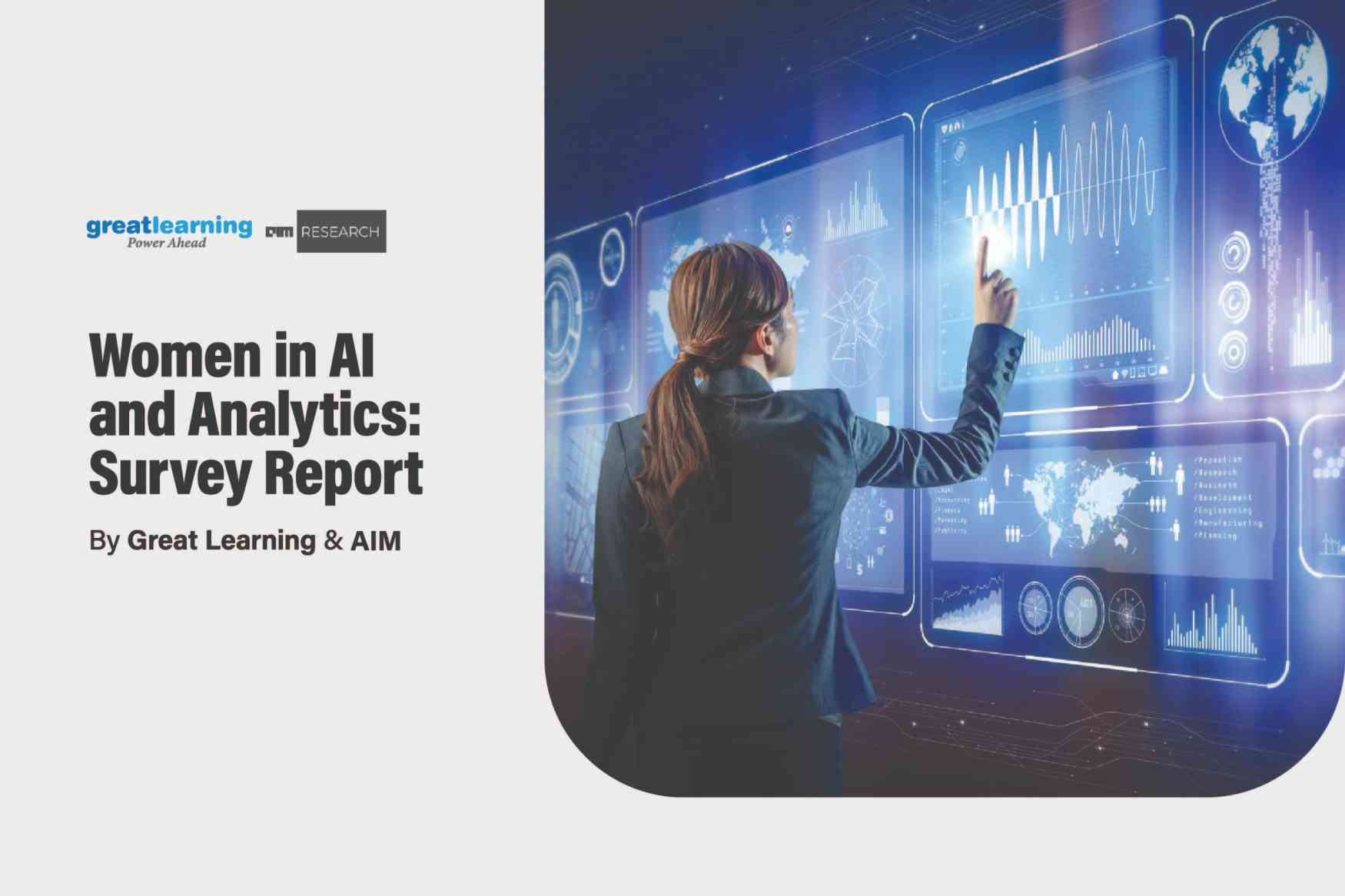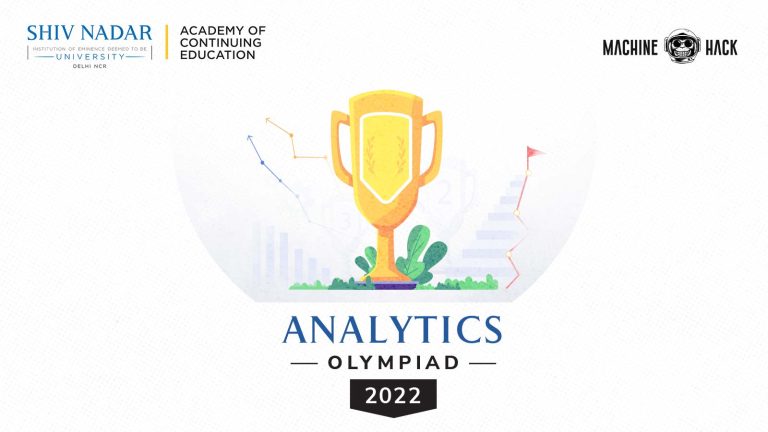Women are breaking the glass ceiling across industries and enterprises, rising to the top echelons of company departments and management. Nevertheless, the involvement of women in the technology sector, and more specifically across the data science domain, is still significantly constrained by lower participation, which is fuelled by possible hiring stereotypes and fixed mindsets around women in science functions v/s women in arts functions.
Research has proven that a diverse workforce improves performance across enterprises. So why is there an acute under representation of women in Analytics and AI? What are the obstacles stopping women from entering these domains?
AIMResearch, in association with Great Learning launched this survey to coincide with Rising in July 2020 – the Conference focused on the contributions of Women in the Data Science domain. AIM has now published the findings of the survey in this report. The findings cover some of the challenges faced by women in the Analytics domain, including overall bias, unequal pay scales, and lack of mentorship, to name a few.
Benefits & Takeaways
The survey findings provide a direct perspective on the gaps and challenges faced by women in the Data Science domain. The survey covered the steps necessary to increase participation of women across the Data Science domain, and specifically in AI and Analytics.
This report will benefit the entire Data Science ecosystem, from the leadership to peer-level workforce, who would get an insight on how the participation of women across the AI and Analytics would be boosted across enterprises – this would create an inclusive workplace environment with different data-centric ideas, and a variety of data interpretations.
Methodology & Response
The report has been developed after rigorous primary research through the process of a survey distributed to all levels of the Data Science workforce regardless of the type of enterprises, experience levels, or gender. This was complemented by direct discussions with leading figures from the AI and Analytics domain to understand and gauge their perspective on the broader participation of Women in AI.
This year AIM released the survey on social media channels, and as a result, the survey received a tremendous response. Moreover, the survey was also promoted during Rising, AIM’s flagship conference on the contribution of Women in the Data Science space. AIM was thus able to get crucial insights on the participation of Women in AI and Analytics from a diverse audience, including several women data science leaders.
Key Findings
The survey was released in the first week of July; the diversity of responses reveals the following:
Greater Opportunities for Women in AI and Analytics Now than 5 Years Ago

Of all the respondents of the survey, 54% affirmed that there were more opportunities for Women in AI and Analytics today than 5 years ago. While this is slightly more than a simple majority, it does reflect the changing bias towards the opportunities for women as well as the ground reality with regards to jobs, and roles available for women in AI and Analytics.
While the figure of 46%, who responded in the negative, highlights the progress that still needs to be made, a greater number of opportunities in AI are opening for women and are bound to increase over the next few years.
Factors that Have Led to an Increase in Opportunities for Women
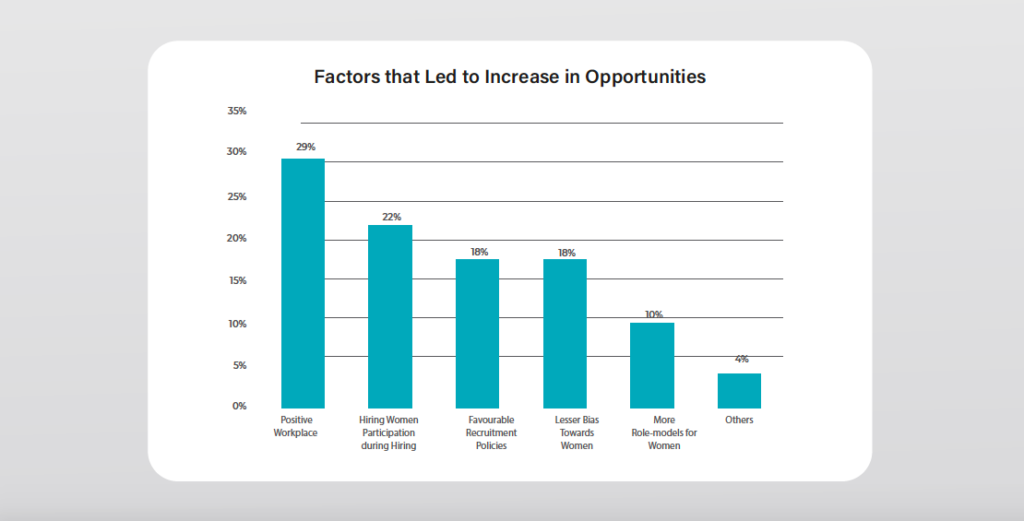
Of those respondents who answered the first question in the affirmative – i.e., there are more opportunities for women in Analytics and AI now than there were 5 years ago, 29% believe that Positive Workplace Policies have led to this increase.
These workplace policies typically cover supporting women in roles of Data Science and providing training/logistics support for such roles. Moreover, the support broadly covers flexi-hours, work from home, and greater maternity leave, among other policies. These policies, which were initiated by the MNC and Domestic IT companies, have now been adopted by a host of company types across functions and domains, including AI and Analytics.
22% of the respondents believe that Greater Participation of Women during the Hiring Process of the Organisations now than 5 years ago has led to this increase. This is so because women candidates are applying to more AI & Analytics roles now than before. A part of this factor is a result of greater women taking up and graduating from Analytics and Data Science programmes, thus presenting numerous opportunities for hiring across AI and Analytics.
18% of the respondents believe that the Favourable Recruitment Policies now against those 5 years ago has led to the increase – companies are reaching out to and shortlisting more women candidates than before. Hence, the perception of hiring men for IT and Data Science roles has changed across companies because of hiring processes and standards. Moreover, companies, during the recruitment process, are very clearly highlighting the benefits, especially for women, that the firms offer along with the role – such as Flexi-hours, Work-life balance, Career Growth, and Training etc.
18% of the respondents believe that a Lesser Bias Towards Women in the Workplace now than 5 years ago has contributed to greater opportunities. While a certain negative bias does exist towards women entering the Data Science field, a smaller negative bias exists now as against 4-5 years ago. This shows that the perception towards Women in Data Science roles is now changing for the better – as a greater number of women role models in Data Science is now emerging.
10% of the respondents believe that there are More Role-models for Women now than 5 years ago, contributing to more opportunities for women. This factor is a direct result of more women rising to significant roles not just in the AI and Data Science domains but also across the broader IT and Technology domains. Senior women Data Scientists and CIOs across industries and organisations are now serving as role models to numerous women seeking a career in AI and Analytics.
Factors that Have Led to a Perception of No Increase in Opportunities for Women
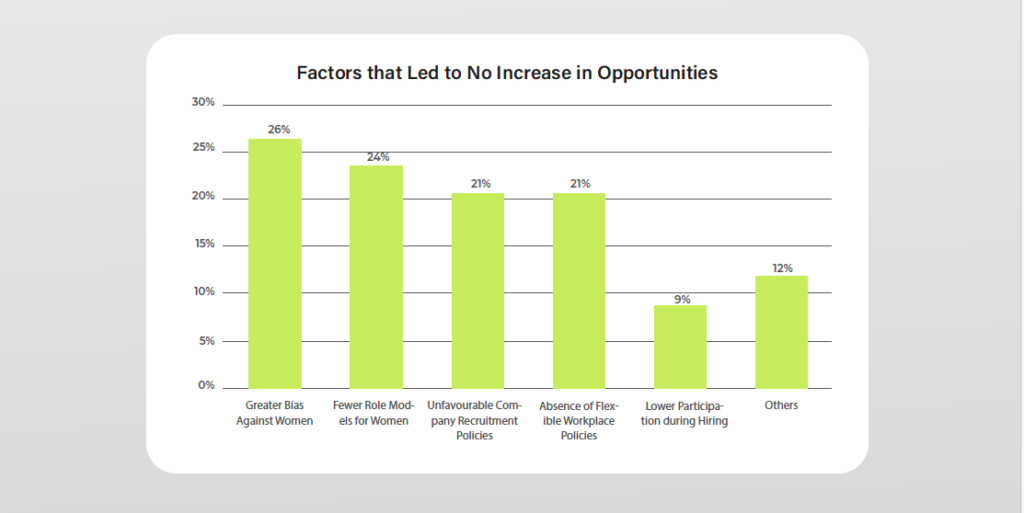
Of the survey participants who responded to the first question in the negative, i.e., there has been no increase in opportunities for women as compared to 5 years ago, 26% believe that the Greater Bias Against Women has led to no increase in opportunities.
These respondents believe that a negative bias in the workplace still exists against women and this covers all the factors from recruitment to roles assigned, and from salaries to appraisals, and overall support.
24% of the respondents who answered in the negative believe that there are Fewer Role Models for Women in AI & Analytics. While from a positive perspective, role models for women do exist in senior Data Science roles and the overall IT sector, there is still a lot of room for improvement in this area.
Greater networking by role models is one of the key areas of improvement – this could include women Data Scientists participating in collaboration sessions, conferences, and workshops at educational institutes and organisations. During these events, networking and outreach would give visibility to the role models across AI & Analytics.
21% of the respondents who answered negatively to the number of opportunities available to women now than 5 years ago believe that Unfavourable Company Recruitment Policies have led to the decrease in opportunities. While company recruitment policies have improved over the last few years, there is room for improvement – companies should reach out to a broader base of women recruiting across AI & Analytics.
For this purpose, exclusive women recruitment events and greater marketing of such events should be undertaken. A similar figure of 21% believes that the Absence of Flexible Workplace Policies has led to the Decrease. Here again, while positive workplace policies exist across organisations, there are numerous organisations that do not provide favourable policies – and intervention from industry bodies would be required to effect change across such organisations and enterprises.
9% of the respondents believe that the smaller participant pool created by the Lower Participation of Women AI & Analytics Professionals during Hiring has led to no increase in opportunities for women. 12% of the respondents believe there are Other reasons for fewer opportunities now than there were 5 years ago.
Factors that will Encourage more Women to Enter AI & Analytics

The respondents believe that certain factors will encourage more women to enter the AI and Analytics domain. 27% of these respondents believe that Equal Growth and Pay for the same level of Experience and Education will encourage more women. The lack of equal growth and pay for women in AI, continues to be a roadblock discouraging many qualified and experienced women from entering this domain.
24% of the respondents believe that women will be encouraged to enter this domain if they have Greater Awareness of the Roles and the Support that Organisations now provide in terms of work-life policies, training, and support. Greater communication and spreading awareness play a key role in changing perceptions among women seeking to join the Data Science domain or looking for greater opportunities.
17% of the respondents believe that Mentoring Support from School to Universities to Firms will encourage more women to enter AI & Analytics roles. This support covers the support starting from the school / colleges covering the matching of overarching career goals with the right kind of programmes or courses that need to be studied. Across organisations, support should be provided in terms of mentoring from experienced professionals in the AI & Analytics domain.
This mentoring would cover ideal career paths across Data Science, as this domain is fast evolving with numerous technology options, such as Computer Vision, Machine Learning, Natural Language Processing (NLP), and Artificial Intelligence (AI). The mentoring also entails chances and opportunities to up-skill through various certifications and programmes. Hence, by encouraging greater mentoring and support starting from schools right up to firms and enterprises, more women would be encouraged to enter the AI & Analytics domain.
16% of the respondents believe that 2 separate factors covering Greater Access to Analytics Education and More Women in Leadership Roles wouldencourage more women. While numerous courses and programmes exist, greater access to education would cover institutions and universities reaching out to women highlighting the facets of programmes in terms of career growth, including the scholarships and support available. This would entail marketing, advertising, and communications targeted at specific demographics.
The final factor, although not in any way a diminishing factor, More Women in Leadership Roles, also at 16%, signifies that a greater proportion of women in Leadership roles across Data Science would serve as an inspiration for many more women to enter AI & Analytics roles.
Gender Based Pay Disparity in AI & Analytics

An almost 3/4th majority – 72% of the respondents believe that there is a pay disparity – women receive lower pay for the same category of role or work carried out in the AI & Analytics domain.
28% of the respondents do not feel that a pay disparity exists. This proportion includes men and women surveyed and believe that no pay disparity exists – moreover, the women respondents (of the 28% proportion who responded that a pay disparity does not exist) would possibly be receiving salaries higher or at par with the salaries of men in AI and Analytics in similar roles.
The next section would cover the degree of pay disparity based on responses from those who answered this question in the affirmative.
Degree of Pay Disparity in Circumstances of Unequal Pay

Of the respondents who believe that a pay disparity exists, 39% affirm that the pay disparity is 50% or above, while a slightly smaller proportion of 38% indicates that the pay disparity was 30-50%. These figures provide an overwhelming insight on the degree of pay disparity that exists in the AI & Analytics space.
A much smaller figure of respondents, 17%, believe that a pay disparity of 15-30% exists. While the smallest figure polled in terms of pay disparity was – 6% who believe that the pay disparity is between 5-15%.
The combined figure of 77% of respondents, who believe that the pay disparity is greater than 30%, shows the systemic problems that pose a hurdle for women joining the analytics function.
Existence of Policies to Ensure Pay Parity

All the respondents of the survey believe that more can be done in terms of policies to ensure pay parity – these responses are in spite of the views on the existence of a pay disparity (Section/Question No.5).
While some organisations do provide equal pay, the formulation and/or pronouncement of stronger and more comprehensive policies on equal pay is being addressed by government institutions and organisation bodies. These stronger policies would guarantee that the issue of pay disparity is tackled right at the grassroots.
Industry bodies and policymakers are working to ensure that robust policies are implemented and that employees and organisation stakeholders are made aware of these policies – simultaneously organisations are adopting other initiatives, such as mentorship and training, to encourage more women in AI & Analytics roles.
Initiatives Taken by Organisations to Encourage More Women in AI & Analytics

Organisations and Industry Associations need to take steps to encourage more women to join AI & analytics roles. While 23% of the respondents believe that Providing Equal Pay & Growth is the key factor to ensure this, there are other factors that should be pursued that would provide incentives.
A similar figure of 23% believe that Encouraging Mentorship in the Workplace would influence more women in Data Science roles – this would cover exclusive mentor-protégé programs for and led by women.
17% of the respondents believe that Increasing Engagement for Women would encourage more women in AI & Analytics. These would include regular feedback sessions, workshops on options for training and development, town hall sessions on the roadmap of Data Science space, and the objectives of the enterprise or firm in terms of Data Science capability/maturity. All these initiatives should be targeted at women, thus increasing their engagement across the organisations.
15% of the respondents believe that Sponsoring Girls and Women for Data Science courses and programmes would encourage more women in AI & analytics, as this would introduce the domains of Data Science to a greater number of women at the grassroots level, thus increasing the pool of women graduating in Data Science programmes.
A similar figure of 15% of the respondents believed that Increasing the Hiring of Women from Education and Technology institutes would also encourage more women.
Cities that Offer the Most Opportunities for Women in AI & Analytics
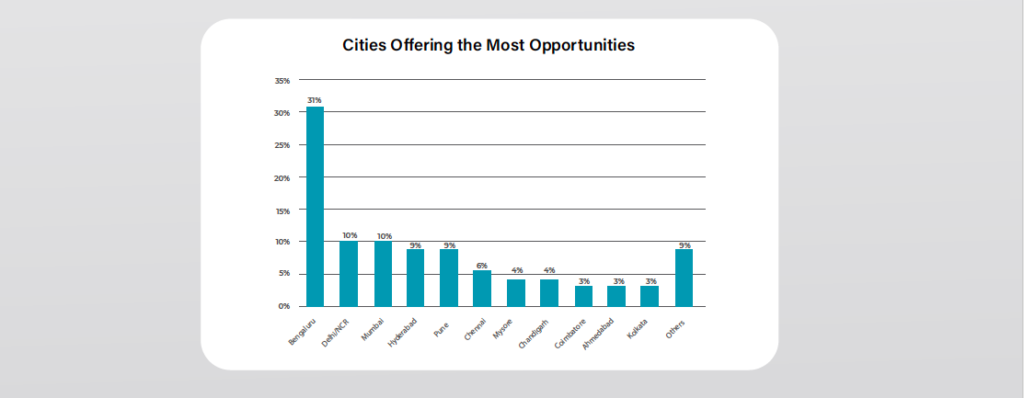
Across all the cities that offer the most AI & Analytics opportunities for Women, Bengaluru has emerged as the leading city of choice, with 31% of the respondents selecting it as the city with most opportunities. Delhi (NCR) and Mumbai are favoured by 10% of the respondents, while Hyderabad and Pune are preferred by 9% of the respondents. The remaining cities have single-digit preferences of 6% or below.
The large gap between Bengaluru and the rest of the cities signifies the importance of India’s Silicon Valley in offering the maximum number of opportunities to Women in AI & Analytics. By attracting Technology companies, Start-ups, Engineering organisations, Consulting firms, and IT firms, Bengaluru has emerged as the favoured destination for opportunities in AI, Computer Vision, NLP, and Analytics. Moreover, the ecosystem (educational institutes, mentoring, and housing etc.) also play a role in offering opportunities to women.
Analytics & AI Roles/Representation across Sectors

Of all the sectors covered through the participants of the survey, the broad IT / ITES sector is represented the maximum – by 36% of the participants. This is followed by the Technology sector, covering both Software and Hardware companies, at 16%.
Pharma & Healthcare, an emerging industry in the broad Data Science domain is represented by 12% of the participants. The broad Automobile / Industrial / Infra sector is represented by 9% of the participants.
The remaining sectors including BFSI, eCommerce, FMCG, Consumer Electronics, Travel & hospitality, and Digital Media have a small yet significant representation in the survey. So, while a little over half of the respondents (52%) are from the broad IT and Technology segments, the remaining 48% of the respondents represent a diverse industry coverage, signifying the emergence of Data Science as a domain spanning many industries and sectors.
Path of Entry to Career in AI & Analytics

The respondents of the survey were asked about how they started their career in the AI & Analytics domain – 31% of the respondents, the highest proportion, have Cross-trained from a non-technology function or domain.
26% of the respondents have upskilled from a related function within IT or Technology. This signifies a combined figure of 57% of respondents who have entered the AI & Analytics domain indirectly. This highlights the opportunities available for a wide variety of prospective career-seekers, who wish to enter the Data Science domain, including Women.
23% of the respondents were Hired or Interned in a Data Science role after Graduation or Post-Graduation. These roles across Data Science were regardless of the type of organisation or industry.
11% of the respondents were Mentored by Leaders in Analytics – this mentorship took place at a decisive stage (including College / University) in the careers of the respondents and covers Mentoring and Guidance for personnel across sectors, domains, and types of firms.
9% of the Respondents are not in the AI & Analytics function/domain and yet they have participated in the survey through an association with Data Science domain in terms cross-functional projects, or personal or academic interest.
Conclusion
As the overall Data Science and Analytics market evolves to adapt to changing business conditions, it is important that organisations, sectors, and industry-bodies, collectively change their perception about Women in AI & Analytics. This should begin with the following:
- Change in perception of Women in AI & Analytics
- Greater communication aimed at women during important stages of the hiring and on-boarding processes
- More support extended to Women as they enter Data Science roles starting from educational firms right up till their actual roles and jobs across organisations
- Mentorship circles and overall support to boost the interest of women for careers in data science
Education and Mentorship both play a key role in ensuring equal pay and opportunities for women in AI. Scholarships for women joining Data Science and AI programmes at school and college levels would ensure that women would enter this field at the grassroots stage itself. In addition to this, at the enterprise level, exclusive online and in-person mentorship programmes on the various career choices available for women in AI, would encourage more women to not just take up a career in AI & Analytics but also establish themselves as career leaders in this domain.
Equal pay emerges as a major factor that discourages women from entering this domain. The fact that all the respondents believed that policies do not exist to ensure equal pay, highlights the need for intervention from the Labour Ministry and Industry associations, such as FICCI and Nasscom.
While many enterprises and organisations are working closely with these associations and departments and taking encouraging steps to encourage more women in Data Science and providing equal pay, there is a greater need for cross-organisation and cross-department collaboration to ensure that policies are developed and enforced for equal pay. This would include such measures as the audit of current laws and policies and amendment of policies at the administrative level. These steps would also cover concrete action to strengthen equal pay protections and combat discriminatory pay practices. These practices and efforts include promoting pay transparency, disclosing disaggregated pay data to enforcement officials, and increasing enforcement efforts through regular, independent audits of personnel salaries and review of company HR policies.
Read the complete report here:


